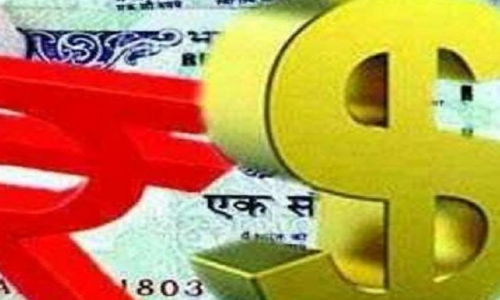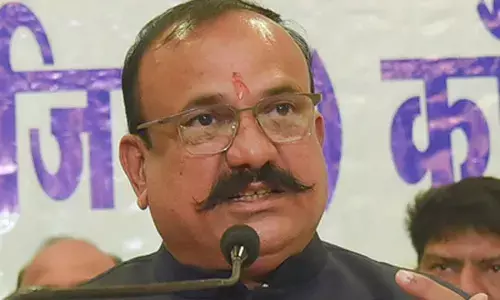Rupee Travails

The Indian rupee is under tremendous pressure in the recent past. A host of global and domestic factors are contributing to this fall in the value of rupee as compared to the US dollar.
The Indian rupee is under tremendous pressure in the recent past. A host of global and domestic factors are contributing to this fall in the value of rupee as compared to the US dollar.
Structural weaknesses of Indian economy are primarily responsible for this situation. In fact, rupee depreciating or devaluing is a recurring phenomenon. The rupee is depreciating much faster when compared to the dollar rather than Euro, Yen or Pound. The reason for this is India's heavy dependence on dollar-denominated assets. Indian trade, India's external debt, and India's external assets are largely in the form of dollars. Thus, excessive dependence on dollar-denominated assets is making the rupee more vulnerable to the US dollar.
Two important developments in the United States economy also have a direct impact on the value of rupee vis-a-vis dollar. First, any recovery in the American economy increases the demand for dollar. As the US is the originating country of the dollar, this currency has a general tendency to swing towards Washington whenever there is a favourable economic climate there. The dollars look towards the emerging economies like India only when the Western, especially American, economy is not yielding better returns.
More precisely, if interest rates are revised by the US Federal Reserve, the dollar has a tendency to appreciate.
The recent past has seen hopes of recovery in the US economy and the possible upward revision in the interest rates thus, creating favourable conditions for the strengthening of dollar. Positive developments in the dollar-originating economy created greater demand for that currency, resulting in depreciation of currencies like Indian rupee.
India's heavy import dependency is also responsible for the greater demand for dollars, creating enormous pressure on the rupee. In the recent past, the upward swing in the global oil prices has increased the burden on India's foreign exchange. India imports nearly 80 per cent of its crude oil requirements. India's import bill which has to be paid in dollars increases drastically with the rise in international oil prices.
Besides, the import liberalisation regime introduced by the economic reforms has led to the spurt in imports. The indiscriminate imports increase the pressure on the Indian currency.
Meanwhile, subsequent to economic liberalisation, Indian corporates are allowed to raise foreign debt or external commercial borrowings (ECB). Thus, liberalised ECB regime prompted Indian business houses to resort to more and more external borrowings as the interest rates on such loans were much less. But, when the economy was sluggish, the corporate profits dwindled and these debts became much more burdensome. The rise in the price of dollar further increased the burden of the foreign dollar-denominated debt.
The economic reforms also introduced the liberalised remittances regime too. Even the Government of India recently acknowledged that the sudden increase in the deposits in Swiss Banks is, perhaps, due to such increased foreign remittances from India. This also increases the demand for dollar exerting undue pressure on Indian currency.
India has been attracting foreign investment as part of economic reforms path. This investment is of two kinds. First, the Foreign Institutional Investments (FIIs) that come into Indian capital markets. The other is the Foreign Direct Investment (FDI) that directly enters the Indian productive economy. Since liberalisation, the trend is that the FIIs dominate such foreign capital flows into India.
These foreign institutional investments into the Indian stock markets is often described as butterfly capital or footloose capital, while the FDI is a stable form of investment. This heavy reliance on FII has made Indian economy more vulnerable to vicissitudes of global economy. Thus, the Indian economy has been experiencing the predatory behaviour of FIIs. As the American economy looks more promising there has been a reverse flow of such foreign capital from India.
All these structural weaknesses like heavy reliance on unstable investment, increased foreign debt, indiscriminate import liberalisation etc., are not a new phenomenon. They have been existing since the economic liberalisation. But, these factors adverse to the value of rupee have worsened in the recent past.
A set of policies are needed to stabilise the value of Indian rupee. First, import-led luxury consumption needs to be discouraged. For instance, the high demand for gold has imposed enormous pressure on India's balance of payments (BoP) and the current account deficit (CAD) has widened. India needs to diversify and increase its exports so that it can earn more dollars.
Exposure of Indian corporate sector to foreign debt needs to be regulated through suitable policy measures. Similarly, suitable curbs should also be imposed on foreign remittances without hurting the investment climate in the country.
Foreign investment into the productive sectors of the economy should be encouraged to avoid unwanted volatility in the Indian stock markets. Indian exports need to be diversified. Indian investment abroad has to be increased.
Finally, the Indian economy has to present opportunities for growth and accelerated incomes. The strength of the domestic economy also defines its external sector too. The domestic savings, domestic investments, domestic markets are the strength of Indian economy. Any external vulnerability to the Indian economy can certainly be avoided by leveraging on the strength of the domestic economy. The fall in the value of rupee impacts Indian economy in multiple ways.
The imports become costlier, thus creating vicious circle. India's foreign debt servicing gets complex with the depreciation of rupee. Higher cost of imports can lead to all-round inflation. Due to high import intensity, even exports can prove to be non-competitive. The CAD worsens. The BOP position gets precarious. Foreign remittances to India will decline as the NRIs prefer to hold back the dollars. Thus, there is no room for complacency on the value of rupee.
2017 saw appreciation of rupee. But, the 2018 has been witnessing steep fall in the value of rupee. Experts forecast that worst days for Indian currency are not yet over. The dollar may even cross Rs 70 mark raising alarm bells. This demands immediate policy intervention. Now that India enjoys fairly comfortable foreign exchange reserves, it cannot afford such depreciation of its currency. The hardening of global oil prices can further make the situation complex. At a time when many other indicators of economy like the growth rates, employment, etc., are not so encouraging, Indian economy cannot afford currency exchange value volatility.

















